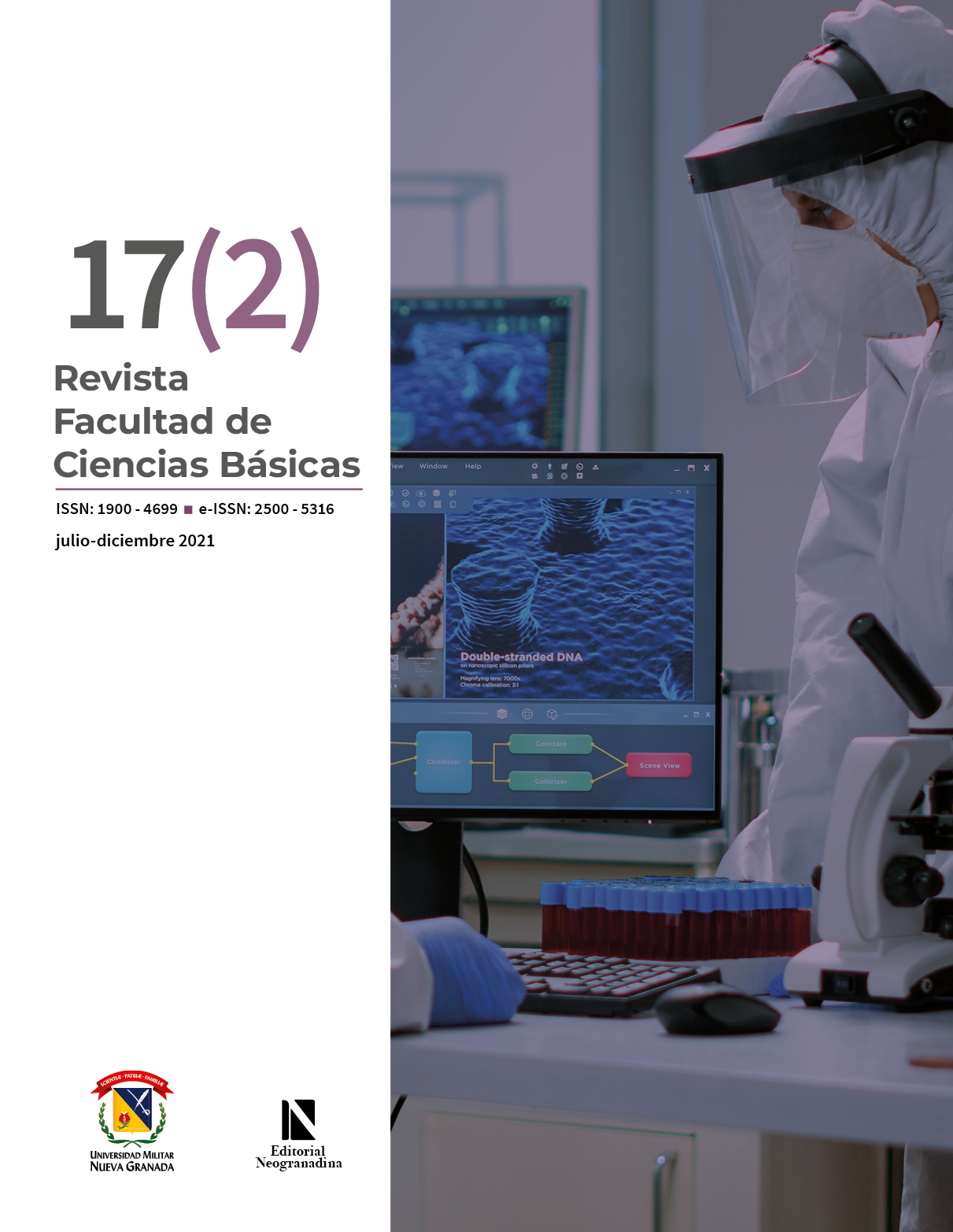Potencial actividad antimicrobiana del péptido BTM-P1 en alimentos
Resumen
Uno de los desafíos de la industria alimentaria es la preservación de los alimentos; para ello se han desarrollado técnicas que prolongan la integridad de sus nutrientes y propiedades sensoriales el mayor tiempo posible. Dentro de los principales problemas está la contaminación bacteriana, que ha sido tratada con antibióticos sintéticos, pero estos pueden dejar residuos tóxicos para el consumo humano. Adicionalmente, existe la preocupación por enfermedades que causarían las bacterias que desarrollan resistencia microbiana por el uso prolongado de antibióticos; por eso se han utilizado alternativas naturales como la nisina, utilizada con éxito desde hace varias décadas, a pesar de algunas limitaciones que se podrían superar investigando y probando con nuevos péptidos antimicrobianos. El péptido btm-P1 es una molécula policatiónica, derivada de la protoxina natural Cry11Bb1 de Bacillus thuringiensis subespecie Medellin, que ha mostrado capacidad para destruir bacterias; esto lo convierte en un potencial preservante de alimentos. El propósito de este trabajo fue evaluar la actividad antimicrobiana del péptido btm-P1 con bacterias típicas de los alimentos, tales como Escherichia coli, Salmonella sp. y Listeria monocytogenes. Dicha actividad se estudió con cultivos a diferentes condiciones fisicoquímicas, con el fin de emular distintos ambientes del péptido en los alimentos. Se mostró que Listeria monocytogenes fue la bacteria con mejor recuperación después de su incubación con el péptido a diferentes temperaturas, y el prealmacenamiento de btm-P1 en ambientes ácidos aumentó su actividad antimicrobiana contra Escherichia coli. Se concluye que el péptido btm-P1 mantiene su actividad antimicrobiana en medios de incubación con pH de 3 a 7 y temperaturas de 4 a 37 ºC.
Descargas
Referencias bibliográficas
M.M. Aung y Y.S. Chang, “Traceability in a food supply chain: Safety and quality perspectives”, Food Control, vol. 39, pp. 172-184, 2014, doi: 10.1016/j.foodcont. 2013.11.007.
G. El-Saber Batiha, D.E Hussein, A.M. Algammal, T.T. George, P. Jeandet, A.E. Al-Snafi, A. Tiwari, J.P. Pagnossa, C.M. Lima, N.D. Thorat, M. Zahoor, M. El-Esawi, A. Dey, S. Alghamdi, H.F. Hetta y N.Cruz-Martins, “Application of natural antimicrobials in food preservation: recent views”, Food Control, vol. 126, pp. 1080-66, 2021, doi: 10.1016/j.foodcont.2021.108066.
D.G. Newell, M. Koopmans, L. Verhoef, E. Duizer, A. Aidara-Kane, H. Sprong, M. Opsteegh, M. Langelaar, J. Threfall, F. Scheutz, J. van der Giessen y H. Kruse, “Food-borne diseases - the challenges of 20 years ago still persist while new ones continue to emerge”, Int. J. Food. Microbiol., vol. 139, pp. S3-S15, 2010, doi: 10.1016/j.ijfoodmicro.2010.01.021.
I.A. Rather, W.Y. Koh, W.K. Paek y J. Lim, “The sources of chemical contaminants in food and their health implications”, Front. harmacol., vol. 8, pp. 830, 2017, doi: 10.3389/fphar.2017.00830.
D.M. Tack, L. Ray, P.M. Griffin, P.R. Cieslak, J. Dunn, T. Rissman, R. Jervis, S. Lathrop, A. Muse, M. Duwell, K. Smith, M. Tobin-D’Angelo, D.J. Vugia, J. Zablotsky, B.J. Wolpert, R. Tauxe y D.C. Payne, “Preliminary incidence and trends of infections with pathogens transmitted commonly through food - foodborne diseases active surveillance network, 10 U.S. Sites, 2016-2019”, mmwr Morb. Mortal. Wkly. Rep., vol. 69, no. 17, pp. 509-514, 2020, doi: 10.15585/mmwr.mm6917a1.
D.C. Love, E.M. Nussbaumer, J. Harding, J.A. Gephart, J.L. Anderson, F. Asche, J.S. Stoll, A.L.Thorne-Lyman y M.W. Bloem, “Risks shift along seafood supply chains” Glob. Food Sec., vol. 28, pp. 1004-76, 2021, doi: 10.1016/j.gfs.2020.100476.
A. J. St. Angelo J. Vercellotti, T. Jacks y M. Legendre, “Lipid oxidation in foods”, Crit. Rev. Food Sci. Nutr., vol. 36, no. 3, pp. 175-224, 1996, doi: 10.1080/10408399609527723.
R. Franco, G. Navarro y E. Martínez-Pinilla, “Antioxidants versus food antioxidant additives and food preservatives”, Antioxidants (Basel), vol. 8, no. 11, pp. 542, 2019, doi: 10.3390/antiox8110542.
C.N. Cutter, “Microbial control by packaging: a review”, Crit. Rev. Food Sci. Nutr., vol. 42, no. 2, pp. 151-161, 2002, doi:10.1080/10408690290825493.
L. Gram, L. Ravn, M. Rasch, J.B. Bruhn, A.B. Christensen y M. Givskov, “Food spoilage--interactions between food spoilage bacteria”. Int. J. Food. Microbiol.,vol. 78, no. 1-2, pp. 79-97, 2002, doi: 10.1016/s0168-1605(02)00233-7.
D. Dave y A.E. Ghaly, “Meat spoilage mechanisms and preservation techniques: a critical review”, Am. J. Agric. Biol. Sci., vol. 6, no. 4, pp. 486-510, 2011, doi:10.3844/ajabssp.2011.486.510.
B. Ramos, F.A. Miller, T.R.S. Brandão, P. Teixeira y C.L.M. Silva, “Fresh fruits and vegetables - an overview on applied methodologies to improve its quality and safety”, Innov. Food. Sci. Emerg. Technol., vol. 20, pp. 1-15, 2013, doi: 10.1016/j.ifset.2013.07.002.
N. Upadhyay, A. Goyal, A. Kumar, D. Lal Ghai y R. Singh, “Preservation of milk and milk products for analytical purposes”, Food Rev. Int., vol. 30, no. 3, pp. 203-224, 2014, doi: 10.1080/87559129.2014.913292.
M. Zarei, N. Basiri, A. Jamnejad y M.H. Eskandari, “Prevalence of Escherichia coli O157:H7, Listeria monocytogenes and Salmonella spp. in beef, buffalo and lamb using multiplex pcr”, Jundishapur J. Microbiol., vol. 6, no. 8, pp. e7244, 2013, doi: 10.5812/jjm.7244
R.E. Patiño-Burbano, A.K. Carrascal, J. L. Parra-Arango, J. L. Rodríguez-Bautista y J. C. Salcedo-Reyes, “Assessment of a multiplex detection method for Salmonella enterica, Escherichia coli O157:H7, and Listeria monocytogenes in cow milk”, Univ. Sci., vol. 24, no. 1, pp. 200-217, 2019, doi:10.11144/javeriana.sc24-1.aoam.
E. Abebe, G. Gugsa y M. Ahmed, “Review on major food-borne zoonotic bacterial pathogens”, J. Trop. Med., vol. 2020, ID. 4674235, 2020, doi:10.1155/2020/4674235.
C. Kirchhelle, “Pharming animals: a global history of antibiotics in food production (1935–2017)”, Palgrave Commun., vol. 4, no. 96, 2018, doi: 10.1057/s41599-018-0152-2.
Chen, G.G. Ying y W.J. Deng, “Antibiotic residues: extraction, analysis, and human health concerns”,J. Agric. Food. Chem., vol. 67, no. 27, pp. 7569-7586, 2019, doi: 10.1021/acs.jafc.9b01334.
Vaishali, P. Jhandai, V.J. Jadhav y R. Gupta, “Bio-preservation of foods: a review”, Eur. J. Nutr. Food. Saf., vol. 11, no. 4, pp. 164-174, 2019, doi: 10.9734/ejnfs/2019/v11i430159.
M. Rai, R. Pandit, S. Gaikwad y G. Kövics, “Antimicrobial peptides as natural bio-preservative to enhance the shelf-life of food”, J. Food Sci. Technol., vol. 53, no. 9, pp. 3381-3394, 2016, doi: 10.1007/s13197-016-2318-5.
E. Dell’Olmo, R. Gaglione, M. Sabbah, M. Schibeci, A. Cesaro, R. Di Girolamo, R. Porta y A. Arciello, “Host defense peptides identified in human apolipoprotein B as novel food biopreservatives and active coating components”, Food Microbiol., vol. 99, pp:103-804, 2021, doi.org/10.1016/j.fm.2021.103804.
M.L. Heymich, S. Srirangan y M. Pischetsrieder, “Stability and activity of the antimicrobial peptide Leg1 in solution and on meat and its optimized generation from chickpea storage protein”, Foods, vol. 10, no. 6, pp: 1192, 2021, doi: 10.3390/foods10061192
Y.L. Vishweshwaraiah, A. Acharya, V. Hegde y B. Prakash, “Rational design of hyperstable antibacterial peptides for food preservation”, npj Sci. Food, vol. 5, no. 1, pp. 26, 2021, doi:10.1038/s41538-021-00109-z.
A. Gharsallaoui, N. Oulahal, C. Joly y P. Degraeve, “Nisin as a food preservative: part 1: physicochemical properties, antimicrobial activity, and main uses”, Crit. Rev. Food Sci. Nutr., vol. 56, no. 8, pp. 1262-1274, 2016, doi: 10.1080/10408398.2013.763765.
K. Rayman, N. Malik y A. Hurst, “Failure of nisin to inhibit outgrowth of Clostridium botulinum in a model cured meat system”, Appl. Environ. Microbiol., vol. 46, no. 6, pp. 1450-1452, 1983, doi: 10.1128/ AEM.46.6.1450-1452.1983.
A. Sobrino-López y O. Martín-Belloso, “Use of nisin and other bacteriocins for preservation of dairy products”, Int. Dairy J., vol. 18, pp. 329-343, 2008, doi: 10.1016/j.idairyj.2007.11.009.
M.L. Van Tassell, L.A. Ibarra-Sánchez, S.R. Takhar, S.L Amaya-Llano y M.J. Miller, “Use of a miniature laboratory fresh cheese model for investigating antimicrobial activities” J. Dairy Sci., vol. 98 (26454301), pp. 8515-8524, 2015, doi: 10.3168/jds.2015-9967.
C.N. Cutter y G.R. Siragusa, “Population reductions of gram-negative pathogens following treatments with nisin and chelators under various conditions”, J. Food. Prot., vol. 58, no. 9, pp. 977-983, 1995, doi: 10.4315/0362-028X-58.9.977
J.K. Branen y P.M. Davidson, “Enhancement of nisin, lysozyme, and monolaurin antimicrobial activities by ethylenediaminetetraacetic acid and lactoferrin”, Int. J. Food Microbiol., vol. 90, no. 1, pp. 63-74, 2004, doi: 10.1016/s0168-1605(03)00172-7.
I.S. Boziaris, L. Humpheson y M.R. Adams, “Effect of nisin on heat injury and inactivation of Salmonella enteritidis pt4”, Int. J. Food Microbiol., vol. 43, no. 1-2, pp. 7-13, 1998, doi: 10.1016/s0168-1605(98)00083-x
W. Liu y J.N. Hansen, “Some chemical and physical properties of nisin, a small-protein antibiotic produced by Lactococcus lactis”, Appl. Environ. Microbiol., vol. 56 (2119570), pp. 2551-2558, 1990.
E.A. Davies, H.E. Bevis, R. Potter, J. Harris, G.C. Williams y J. Delves-Broughton, “Research note: The effect of pH on the stability of nisin solution during autoclaving”, Lett. Appl. Microbiol., vol. 27, pp. 186-187, 1998, doi: 10.1046/j.1472-765X.1998.t01-1-00401.x
V.V. Lemeshko, M. Arias y S. Orduz, “Mitochondria permeabilization by a novel polycation peptide btm-P1”, J. Biol. Chem., vol. 280, no. 16, pp. 15579-15586, 2005, doi: 10.1074/jbc.M414064200
C. Segura, F. Guzmán, L.M. Salazar, M.E. Patarroyo, S. Orduz y V. Lemeshko, “BTM-P1 polycationic peptide biological activity and 3D-dimensional structure”, Biochem. Biophys. Res. Commun., vol. 353, no. 4, pp. 908-914, 2007, doi: 10.1016/j.bbrc.2006.12.113.
V.V. Lemeshko, F. Guzmán, M.E. Patarroyo, C. Segura y S. Orduz, “Synthetic peptide having an ionophoric and antimicrobial activity”. U.S. Patent No. 7.041.647, 2005.
V.V. Lemeshko, “Permeabilization of mitochondria and red blood cells by polycationic peptides btm-P1 and retro-btm-P1”, Peptides, vol. 32, no. 10, pp. 2010- 2020, 2011, doi: 10.1016/j.peptides.2011.08.023.
J.M. Andrews, “Determination of minimum inhibitory concentrations”, J. Antimicrob. Chemother. vol.48, no. 1, pp. 5-16, 2001, doi:10.1093/jac/48.suppl_1.5.
Clinical and Laboratory Standard Institute (clsi), “Methods for dilution antimicrobial susceptibility tests for bacteria that grow aerobically”, approved standard-ninth edition, M07-A9, vol. 32, no. 2, pp. 18-20, 2012.
J.M. Shin, I. Ateia, J.R. Paulus, H. Liu, J.C. Fenno, A.H. Rickard y Y.L. Kapila, “Antimicrobial nisin acts against saliva derived multi-species biofilms without cytotoxicity to human oral cells”, Front. Microbiol., vol. 6, pp. 617, 2015, doi: 10.3389/fmicb.2015.00617
A.P. Schellinger y P.W. Carr, “Solubility of Buffers in Aqueous-Organic Eluents for Reversed-Phase Liquid Chromatography”, lcgc North America, vol. 22, no. 6, pp. 544-548, 2004.
N. Malanovic y K. Lohner, “Gram-positive bacterial cell envelopes: the impact on the activity of antimicrobial peptides”, Biochim. Biophys. Acta, vol.1858, no. 5, pp. 936-946, 2016, doi: 10.1016/j.bbamem.2015.11.004.
G. Bhardwaj, V. Khipple, C.D. Bahl, J.M. Gilmore, P.J. Harvey, O. Cheneval, G.W. Buchko, S.V.S.R.K Pulavarti, Q. Kaas, A. Eletsky, P.S. Huang, W.A. Johnsen, P.J. Greisen, G.J. Rocklin, Y. Song, T.W. Linsky, A. Watkins, S.A. Rettie, X. Xu, L.P. Carter, R. Bonneau, J.M. Olson, E. Coutsias,
C.E. Correnti, T. Szyperski, D.J. Craik y D. Baker, “Accurate de novo design of hyperstable constrained peptides”, Nature, vol. 538, pp. 329-335, 2016, doi: 10.1038/nature19791.
D. Bogahawaththaa, J. Chandrapalaab y T. Vasiljevic, “Thermal denaturation of bovine immunoglobulin G and its association with other whey proteins”. Food Hydrocoll., vol. 72, pp. 350-357, 2017, doi: 10.1016/j.foodhyd.2017.06.017.
A. Bañares-Hidalgo, J. Pérez-Gil y P. Estrada, “Acidic pH triggers conformational changes at the nh2-terminal propeptide of the precursor of pulmonary surfactant protein B to form a coiled coil structure”, Biochim. Biophys. Acta, vol. 1838, no. 7, pp. 1738-1751, 2014, doi: 10.1016/j.bbamem.2014.03.016.
V. Cabra, R. Arreguin, R. Vásquez-Duhalt y A. Farres, “Effect of temperature and pH on the secondary structure and processes of oligomerization of 19 kDa alpha-zein”, Biochim. Biophys. Acta, vol. 1764, no. 6, pp. 1110-1118, 2006, doi: 10.1016/j.bbapap.2006.04.002.
J. Membre, B. Leporq, M. Vialette, E. Mettler, L. Perrier, D. Thuault y M. Zwietering,“Temperature effect on bacterial growth rate: quantitative microbiology approach including cardinal values and variability estimates to perform growth simulations on/in food”. Int. J. Food Microbiol., vol. 100, no. 1-3, pp. 179-186, 2005, doi: https://doi.org/10.1016/j.ijfoodmicro.2004.10.015.
E. Gasteiger, C. Hoogland, A. Gattiker, S. Duvaud, M.R. Wilkins, R.D. Appel y A. Bairoch, “Protein identification and analysis tools on the ExPASy Server”, (In) John M. Walker (ed): The Proteomics Protocols Handbook, Humana Press, 2005.
V.V. Lemeshko y S. Orduz, “Electrical hypothesis of toxicity of the Cry toxins for mosquito larvae”, Biosci Rep., vol. 33, no. 1, pp. 125-136, 2013, doi: 10.1042/BSR20120101.
H.M. Werner, C.C. Cabalteja y W.S. Horne, “Peptide backbone composition and protease susceptibility: impact of modification type, position, and tandem substitution”, Chembiochem., vol. 17, no. 8, pp. 712- 718, 2016, doi: 10.1002/cbic.201500312.
R. Rink, A. Arkema-Meter, I. Baudoin, E. Post, A. Kuipers, S.A. Nelemans, M. Haas Jimoh y G.N. Moll, “To protect peptide pharmaceuticals against peptidases”, J. Pharmacol. Toxicol. Methods, vol. 61, no. 2, pp. 210-218, 2010, doi: 10.1016/j.vascn.2010.02.010.

Derechos de autor 2023 Revista Facultad de Ciencias Básicas

Esta obra está bajo una licencia internacional Creative Commons Atribución-NoComercial-SinDerivadas 4.0.











